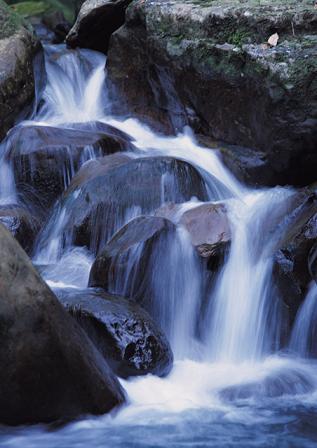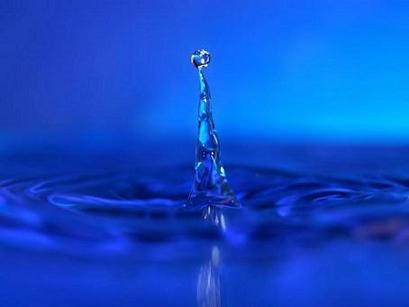THE WATER
SUPPLY PROBLEM
| Shortages of fresh water have troubled people throughout history. Today, they trouble people more than ever because the demand for water is growing rapidly. Many people fear that the world does not have enough water to meet all our needs. Yet the world has-and always will have-the same amount of water it has always had. All the water we use passes through the great water cycle and can be used again and again.
|
 |
The total amount of water on Earth is enough for all our needs. However, Earth's water is distributed unevenly. Some regions suffer a constant drought (lack of rain). Other regions generally have plenty of water, but they may be struck by drought at times. In addition, people have created many water problems by mismanaging the supply.
World distribution of water.
Earth has an enormous amount of water-about 326 million cubic miles (1.4 billion cubic kilometers) of it. In a cubic mile, there are more than a million million-1,000,000,000,000-gallons, or 3.8 million million liters. However, 97 percent of this water is in the salty oceans, and more than 2 percent is in glaciers and icecaps. The rest totals less than 1 percent. Most of this water is underground, and the remainder includes the water in lakes, rivers, springs, pools, and ponds. It also includes rain and snow, and the vapor in the air.
A country's water supply is determined by its precipitation. In regions with plenty of precipitation year after year, there is plenty of water in lakes, rivers, and underground reservoirs.
Earth as a whole receives plentiful rain.
If this rain fell evenly, all the land would receive 34 inches (86 centimeters) a year. But the rain is distributed unevenly. For example, over 400 inches (1,000 centimeters) drenches northeastern India every year. But northern Chile may not get rain for years.

Generally, the world's most heavily populated areas receive enough rain for their needs. These areas include most of Europe, Southeast Asia, the Eastern United States, India, and much of China. But about half Earth's land does not get enough rain. These dry areas include most of Asia, central Australia, most of northern Africa, and the Middle East.
The United States has plenty of water. It averages about 30 inches (76 centimeters) of rain annually. This total is large, but it is distributed unevenly. Over 135 inches (343 centimeters) soaks parts of western Washington each year, but Nevada averages only 9 inches (23 centimeters). Most states east of the Mississippi get 30 to 50 inches (76 to 130 centimeters) of precipitation a year-more than enough to grow crops. But large regions in the West get less than 10 inches (25 centimeters). There, only a small amount of grass and shrubs can grow without irrigation.
Canada's annual precipitation is also distributed unevenly. In the southeast, it ranges from 30 inches (76 centimeters) in central Ontario to 55 inches (140 centimeters) in eastern Nova Scotia. From 14 to 20 inches (36 to 51 centimeters) of precipitation falls in most of the Prairie Provinces. Parts of the west coast get over 100 inches (250 centimeters).
Water shortages.
Many regions of the world have a constant water shortage because they never get enough rain. But even a region that normally has enough rain may suddenly have a dry year or several dry years. The climates in regions that receive only light rainfall are especially changeable. Such regions can have a series of destructive dry years.
In the 1930's, one of the worst droughts in United States history struck the Southwest, an already dry region. Winds whipped the dry soil into gigantic dust storms, and most of the region became known as the Dust Bowl. Hundreds of farm families had to leave their homes.
Periods of low rainfall alternate with periods of high rainfall from year to year and from place to place. In the 1980's, for example, drought struck the Midwestern and Southeastern United States, as well as parts of Argentina, Australia, Brazil, Ethiopia, Paraguay, Uruguay, and other countries. Meanwhile, floodwaters spilled over the land in the south-central United States and in parts of Bangladesh, China, India, and other countries.
Many regions have water shortages because the people have not prepared for a period of less than normal rainfall. These shortages could have been prevented if the people had built artificial lakes, storage tanks, and other facilities to carry them through a drought.
The United States is especially rich in water. But every year, a number of U.S. communities must ration their water. As a result, many people fear that the country is running out of water. The United States as a whole has as much water today as the land had when Christopher Columbus sailed to the New World. But rainfall patterns change. In addition, the demand for water is increasing faster in the United States than in any other country. More and more Americans want air conditioners, garbage disposers, automatic washers, and an extra bathroom. Industry also demands more water as production rises. When drought strikes, the effects can be severe.
During the 1960's, rainfall in the Northeastern United States fell below normal for several years. Many cities had to restrict the use of water. New York City suffered especially, because it is so heavily populated. To save water, people turned off their air conditioners and let their lawns wither. Restaurants tried not to serve water to customers. The city was declared a disaster area. New York City's troubles came about because the city did not have enough storage tanks, distribution lines, and other facilities to supply the city with water during a long period of light rainfall. The city improved its facilities after the drought.
Water management and conservation.
Throughout history, people have attempted to increase their water supply by trying to "make rain." They have prayed to rain gods and performed rain dances. They have sprayed the clouds with chemicals to make them release their moisture. People also have always looked to the sea as a source of water (see the section Fresh water from the sea). In many cases, however, people do not need more water than they already have. They only need to manage the supply better.
Many water problems in the United States have arisen because the country has had a plentiful and easily available water supply. Water has been cheap, and people have been careless and wasteful. In the past, they dumped untreated sewage and other wastes into rivers and lakes, spoiling the water. In most U.S. cities, people pay about $1.25 per 1,000 gallons (3,800 liters) of water. In contrast, New York City charges many people a fixed fee for water based on the size of the house or apartment building they live in. The fee is the same no matter how much water a household uses. As a result, many people waste water. However, commercial buildings and large apartment buildings in New York City have water meters, and people pay for the water they use. The city has begun to install water meters in all homes and apartment buildings.

The supply of cheap, easily available water is shrinking in the United States. The development of new supplies will become more and more costly. It will then be cheaper to reuse water from existing supplies. Many industries reuse water. For example, most steel companies use a small amount of water over and over in a circulating cooling system.
|
Sewage, also called wastewater, can be treated and turned into usable water. Many communities in California, Florida, Texas, and other states irrigate crops with treated wastewater. Water reuse will become much more common in the future. Next>>>
|
|



